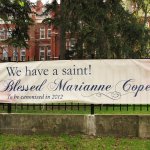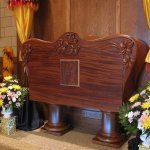Twelve-year-old Charlotte Toguchi had to make a decision. Which should she choose? The Liberty cotton or the Swiss? The periwinkle blue or the coral? The stripes or the tiny flamingo print? Her art teacher had convinced her that she had a special aptitude for color, so she felt confident in choosing the fabric for her new dress. But this was no ordinary dress. This was her recital dress! She had been taking voice lessons for over a year now and this would be her first solo performance. In front of the entire school. She was as excited as a toddler on Christmas morning. Later that day she would be meeting with her dress designer.
Private art lessons. Music lessons. Designer dresses. Who was this pampered child? Surely, she must be one of the elite. Exclusive boarding schools? Privileged background? Trust funds? No, Charlotte’s background was nothing like that. Charlotte was a patient at the leper colony on the island of Molokai in Hawaii, the one made famous by the legendary Belgian-born Father Damien de Veuster, who was canonized in 2009 by Pope Benedict.
And Charlotte’s fashion designer? Her name was Sister Marianne Cope, a Franciscan sister from Syracuse, New York, who was in charge of the women and girls at the settlement. The cheerful and kindly Sister Marianne loved color, the more vibrant the better. She loved fashion too. Not for herself, of course! She was quite content with her black and white habit. But for her girls on Molokai, she wanted the latest styles. Only the best for them. She and her sisters pored over the latest fashion magazines. According to all reports, Sister Marianne was quite the fashion designer and an excellent seamstress as well. Although the sisters’ days were spent in prayer and work at the hospital, many evenings found the sisters happily buzzing away at their sewing machines.
When word got out about Molokai’s newest fashion designer, manufacturers began donating beautiful fabrics to the convent. The finest of Egyptian and Swiss cottons soon began arriving—by the truckload. Surroundings were important to Sister Marianne too; she planted flowers and trees and shrubs everywhere. She wanted the patients at Molokai to be immersed in beauty and color and flowers and music. Education and sports were emphasized as well. She wanted her charges to be happy and to know their own dignity. And the girls’ cottages were no drab affairs either: they were all painted in pastel tones of aqua, buttercup yellow and primrose pink. Hibiscus bushes—which come in a wild variety of shades—bloomed everywhere.
It all began with a letter: Hawaiian missionary priest Father Leonor Fousnel was desperate for nurses in Hawaii. He wrote to more than fifty superiors of religious orders in Canada and the U.S. “Have pity on our poor sick!” he pleaded. All refused. Except one: Sister Marianne Cope, the provincial superior of the order of St. Francis in Syracuse, New York.
“My interest is awakened. I feel an irresistible force driving me to follow this call,” she replied. The priest, however, withheld one vital piece of information: that the sisters would be working with lepers! This, however, did not deter Sr. Marianne. “I am hungry for the work!” she said “and I wish with all my heart to be one of the Chosen Ones whose privilege it will be, to sacrifice themselves for the salvation of the souls of the poor Islanders—hence it would be my greatest delight to minister to the abandoned lepers.”
She was born in Germany in 1832 and her family moved to Utica, New York, a year later. The desire for religious life came early for her, but because of family obligations she worked in a factory for nine long years before she could enter the convent. In 1862 she joined the new Franciscan religious order in Syracuse and was elected provincial superior fifteen years later. By this time the order included 62 sisters, nine schools and two hospitals. The eminently capable Sister Marianne became the director of the Syracuse hospital. A gifted administrator, she was renowned for her ability to “smooth the way and soothe the ego.”
On Oct. 22, 1883, Sister Marianne and six of her sisters set out for Hawaii. She intended to stay for six months but ended up spending the rest of her life on the island. They would arrive five months before Father Damien’s death of leprosy at the age of 49. He was overjoyed to see the sisters and to know that they would be continuing his work.

In 1865 a proclamation had been issued by the Hawaiian government which exiled leprosy patients to a corner of Molokai, “one of the most isolated spots on the globe.” According to one 80-year-old resident, conditions were horrible for the patients in the early days. There were no houses, no schools, no doctors, no churches, nothing except scant rations of food provided by the government. Lawlessness and chaos prevailed. Until May 10, 1873, that is. That day marked the arrival of 35-year-old Father Damien. “His coming was like a breath of fresh ocean air,” said one elderly patient. The industrious and self-sacrificing Father Damien would spend the rest of his life on Molokai with his “beloved lepers.” Under his efficient administration “basic laws were enforced, shacks became painted houses and working farms were organized.” Realizing the need for joy in each patient’s life he organized choirs, an orchestra, sports teams and picnics. He was a superb missionary as well—within 6 months he had 400 eager new catechumens.
A few months before Father Damien’s death an Englishman, Edward Clifford, visited the settlement. He was expecting the worst. He was startled to discover that the lepers seemed cheerful and “singularly happy.” “Do you mind being here?” he asked one of the patients. “Oh, no!” she answered. “We’re well off here and we like our pastor. He builds our houses himself. He gives us tea, biscuits, sugar, and clothes. He takes good care of us and doesn’t let us want for anything.”
Sister Marianne and her sisters continued his legacy. Walter Murray Gibson, the Minister of Health for Hawaii, a regular visitor, was smitten with “these angels of mercy.” One spectator spoke of his visits: “Into that forlorn place—Gibson’s coach would enter, like that of Cinderella’s godmother, bringing gifts from him to brighten the hospital or the convent.” “He fell in love with these kindly sisters,” said one observer. To be more accurate, the widowed Gibson fell in love with one particular sister more than all the others: Sister Marianne. After his death his diary revealed his “crush on the beautiful and charming mother superior.”
Scottish writer Robert Louis Stevenson visited the colony in 1889. So impressed was he with Sister Marianne that he wrote a poem about her:
To see the infinite pity of this place,
The mangled limb, the devastated face,
The innocent sufferers smiling at the rod,
A fool were tempted to deny his God.
He sees and shrinks; but if he look again,
Lo, beauty springing from the breast of pain!
He marks the sisters on the painful shores,
And even a fool is silent and adores.
In gratitude, he sent them a piano, “a very grand five-hundred-dollar piano,” said Sister Leopoldina, who worked with Sister Marianne at the colony for 33 years. After the piano arrived, “there was always music—and the girls had beautiful voices,” she said.
Sister Leopoldina would not have been at all surprised that Sister Marianne would be canonized by Pope Benedict on Oct. 21, 2012, on World Mission Sunday. She spoke of Sister Marianne—“whose spirit seemed to fill one’s weary heart with new life and strengthen the fainting spirit.” Sister Marianne died in 1918 at Molokai of natural causes.
And Charlotte and her recital? By all accounts she was a sensation. And the dress? “She looked like a model from a Paris runway!” said Sister Marianne, encourager extraordinaire.











